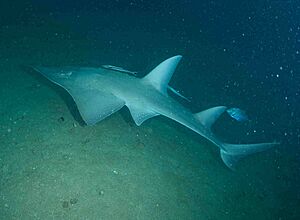White-spotted guitarfish facts for kids
Quick facts for kids White-spotted guitarfish |
|
|---|---|
 |
|
 |
|
| Conservation status | |
| Scientific classification | |
| Genus: |
Rhynchobatus
|
| Species: |
australiae
|
 |
|
| IUCN range of Rhynchobatus australiae
Extant (resident) |
|
The white-spotted guitarfish, also known as Rhynchobatus australiae, is a special type of fish. People also call it the white-spotted wedgefish or bottlenose wedgefish. It belongs to the Rhinidae family.
You can find this fish in warm waters, from shallow areas down to at least 60 meters (about 200 feet) deep. It lives across the Indo-Pacific region. This huge area stretches from the coast of East Africa and the Red Sea, all the way to Taiwan, the Philippines, and Australia. The white-spotted guitarfish is part of a group of similar fish. This group includes the giant guitarfish, the broadnose wedgefish, and maybe even the smoothnose wedgefish.
What Does It Look Like?
The white-spotted guitarfish can grow quite large. It can reach up to 3 meters (about 10 feet) in length!
Colors and Spots
Younger white-spotted guitarfish, like teenagers, are usually grey or brownish on top. They have a few white spots scattered on their bodies. They also have a clear black spot right above each of their pectoral fins. Above each black spot, you'll see three smaller white spots.
As these fish get older and bigger, their color changes. Large adult guitarfish become much darker. They can even look almost black on top. The spots that were easy to see on younger fish often fade away and are hard to notice on adults.
Body Shape
This fish has a unique body shape. Its tail fin has two clear parts, an upper and a lower lobe. This is different from some other rays, like fiddler or shovelnose rays, which have a smaller lower tail fin.
The white-spotted guitarfish has a very pointed snout. This snout smoothly connects to its flat, triangle-shaped pectoral fins. Its gills, which it uses to breathe, are located on the underside of its head. The first dorsal fin (the fin on its back) is lined up with its pelvic fins. You can also find a row of small thorns along the middle of its back.


